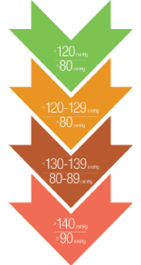It’s estimated that 75 million American adults have high blood pressure, also called hypertension. Along with smoking and high cholesterol, these are the top three risk factors for heart disease and stroke. For high blood pressure, studies show that even mild elevation can put you at a higher risk for heart disease, vascular disease and stroke, which makes it essential to detect, evaluate and manage the condition at its earliest stage.
KNOWLEDGE IS POWER
UHS recently opened its Cardiac Prevention Clinic, staffed by Umama Gorsi, MD, a specialist focusing on preventive heart care. Clinic sessions are held every Tuesday, from 4 to 6 p.m., at UHS Cardiology – Wilson Square.
The clinic’s rationale, says Dr. Gorsi, is simple: “Prevention is better than cure.” By that, the doctor means that every clinic session focuses on aspects to help lower heart attack risk. Topics include heart-healthy diet, weight loss, quitting cigarettes, cutting back on alcohol and increased physical activity.
“For each clinic attendee, we’ll evaluate cardiac risk factors and how we can help lower those risks,” Dr. Gorsi explains.
For more information about the UHS Cardiac Prevention Clinic, call 763-6580.
Going Full Circle
With this in mind, the American College of Cardiologists (ACC) and the American Heart Association (AHA) recently announced new guidelines for high blood pressure—the first comprehensive update since 2003. The primary change introduces a new category of hypertension called Elevated Blood Pressure. Those with readings of 130/80 are now considered to have high blood pressure. Previously, high blood pressure was defined as 140/90.
“The new category identifies those with mild hypertension, so physicians can act sooner with early treatment and preventive healthcare,” explains Afzal ur Rehman, MD, PhD, vice president for Cardiovascular Services and Medical Informatics at UHS.
“It’s also a wake-up call for patients to do their part by making healthy lifestyle changes and improving medication compliance.”
What Goes Up Should Come Down
High blood pressure occurs when coronary arteries that serve the heart become narrowed or blocked from a buildup of plaque, which includes fat and cholesterol. This causes an increase in pressure from blood flow pushing against blood vessel walls. The added pressure damages artery tissues and, over time, damages the heart and circulatory system, which can result in a heart attack or stroke.
The recently released blood pressure guidelines have actually increased the number of U.S. adults diagnosed with high blood pressure, going from 32 percent in 2016 to 46 percent in 2017. “The increase is because our new guidelines identify patients who were once considered within the normal blood pressure range, and these people weren’t being monitored, screened or educated,” Dr. Rehman emphasizes. “The new guidelines identify patients with hypertension at a very early stage, so we can take steps to prevent progression. With earlier intervention, there is every reason to believe that there will be a significant decrease in the percent of adults who progress to high blood pressure stage 1 or 2. When we accomplish this, it stands to reason that we’ll also see a decrease in those who suffer from heart disease or stroke,” Dr. Rehman adds.
KNOW YOUR BLOOD PRESSURE – AND WHAT TO DO ABOUT IT*
Normal Blood Pressure
Recommendations: Healthy lifestyle choices and yearly checks.
Elevated Blood Pressure
Recommendations: Healthy lifestyle changes, reassessed in 3-6 months.
High Blood Pressure Stage 1
Recommendations: 10-year heart disease and stroke risk assessment. If less than 10 percent risk, lifestyle changes and reassessed in 3-6 months. If higher, lifestyle changes and medication with monthly follow-ups until blood pressure is controlled.
High Blood Pressure Stage 2
Recommendations: Lifestyle changes and medication, with monthly follow-ups until blood pressure is controlled
*Talk to your doctor for individualized recommendations.
Source: American Heart Association News
Ready For Your Close Up
Alan Miller, MD, a primary care physician and president of the UHS Medical Group, says: “By identifying patients with even mildly elevated blood pressure, doctors can create more comprehensive and accurate patient cardiac risk profiles. The new guidelines include collecting applicable patient information, then calculating the patient’s risk of heart disease or stroke over the next 10 years.” The information includes patient age, gender, race, total cholesterol, HDL cholesterol and blood pressure. It also features yes-or-no questions as to whether the patient is currently being treated for high blood pressure, is diagnosed with diabetes or is a smoker.
The calculated result is designed to prompt thorough doctor-patient conversations about primary and non-modifiable cardiac risk factors, such as age, ethnicity and family history of heart disease, as well as secondary and modifiable risk factors, which include lifestyle factors that can be controlled.
To help patients understand and manage all these factors, UHS created its Cardiac Prevention Clinic. “The clinic is not only for those who have already had a cardiac event. It’s also for those who want to lower their risk factors for an event,” Dr. Rehman says.
Between the new hypertension guidelines and the UHS Cardiac Prevention Clinic, Dr. Rehman feels that the patient gains a strong benefit. “This gives us time to explore nonpharmacological lifestyle changes with follow-up screenings to see if we’re getting the job done,” Dr. Rehman explains. “If not, we have time to turn to medical therapy. We’re ready with options.”








